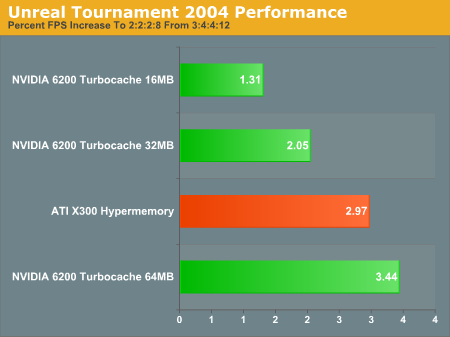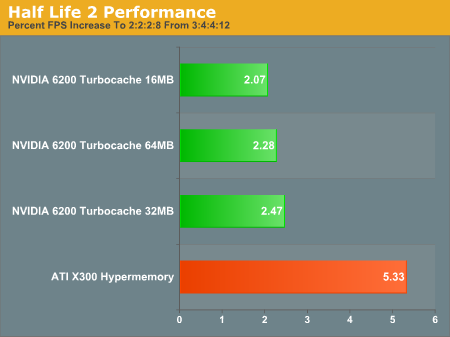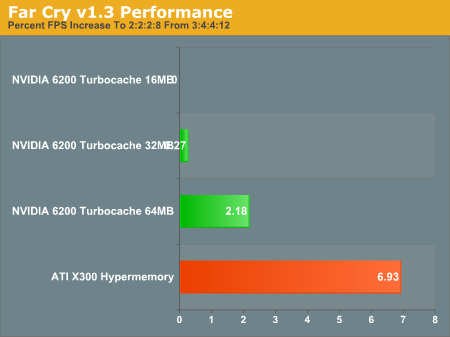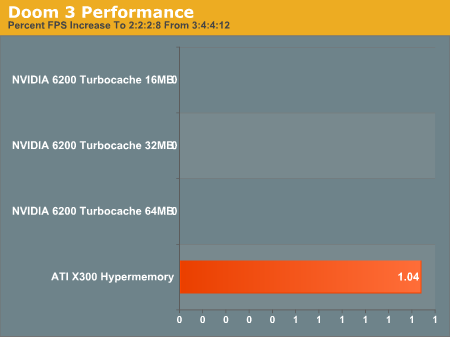Budget Graphics Strike Back: Revenge of the RAM
by Derek Wilson on May 19, 2005 5:40 AM EST- Posted in
- GPUs
DDR400 3:4:4:12 Graphics Performance
Our initial tests were with 2:2:2:8 timings at DDR400. We found that cheap 512MB sticks of CL 3 DDR400 could be had for next to nothing, and system builders will no doubt get a further discount. Buying complete systems with a cheap (high latency) gigabyte of PC3200 and a TurboCache or HyperMemory card shouldn't be much of a problem. To be sure that our tests reflect cheap memory well, we used 3:4:4:12 timings and increased our command rate from 1T to 2T. This should do well to represent cheap DDR400 RAM.Our graphs will show the percentage performance advantage that 2:2:2:8 1T has over 3:4:4:12 2T memory when paired with our budget cards. Our tests were performed at 800x600 with no AA/AF enabled, as we had previously determined this to be our performance sweet spot for these cards. Graphs will be sorted in order of how resilient they are with respect to memory speed. Cards that run at more consistent framerates on fast and slow RAM will be near the top, and cards that benefit more from faster memory will be near the bottom.
Upon examination, the graphs reveal counter-intuitive data. We see that the 64MB TC card and the ATI card generally benefit the most when moving from slow to fast RAM. We would think that the more local RAM that a card has, the less dependent that the card will be on system RAM. We can see here that this simply isn't the case.





Even when comparing the 16MB and 32MB TC cards (which have the same clock speeds), we see that the 16MB card's performance is most consistent. In the end, the 32MB card still performs the best followed by the 64MB TC card, the HyperMemory card, and the 16MB TC card.










21 Comments
View All Comments
kobymu - Saturday, May 21, 2005 - link
I was hoping for some information about how these card suffer/gain in performance when move from the AMD platform to INTEL's, considering the differences in memory subsystem.1.Assuming that the graphic card will deploy some sort of DMA, in an Intel platform, it should have a shorter path (only needs to go through the northbridge) as opposed Amd (pci-e controller/chipset -> integrated memory controller on Amd cpu).
2.DDR2?
AtaStrumf - Friday, May 20, 2005 - link
Yea I know, my spelling sucks. But hey, nobody is perfect :-)Rand - Friday, May 20, 2005 - link
xsilver - Friday, May 20, 2005 - link
sintax = syntaxsorry... I usually dont correct people on spelling but it was funny cause you were talking about language and spelt something wrong :P
AtaStrumf - Friday, May 20, 2005 - link
OK, I guess technically, in this particular case you're right, that the order can be reverse of what is logical and still get the right message across, I just think it's more than a little bit confusing.English language in general, not unlike programming language, is however extremely depedent on the order of words (sintax), because it's grammar is very simple, missing many, shall we say "features", of other languages like declension for example, that's why I think it's important to keep it right.
If you're interested you can read up on my language here:
http://www.absoluteastronomy.com/encyclopedia/S/Sl...
Our grammar's complexity has to be second only to that of chinese'/arabic scribble, so most of us over her are inherently grammar experts :-)
OK, I'll stop bugging you now ;-)
JarredWalton - Friday, May 20, 2005 - link
Now we just need to get Derek to run some tests with 2.5-3-3 RAM and a realistic CPU choise like a Celeron of Athlon 64 3000+. ;)DerekWilson - Thursday, May 19, 2005 - link
As I said -- I cannot say decrease, as the percentage was calculated as an increase. Sorry I forgot to mention that I'm not going to recaculate my data and reenter it into the graphing engine in order to call it a decrease when all I need to do is change a couple words :-)Besides, all of the percentage data in our processor and graphics articles is a percent increase. Why break tradition now :-)
Lexically, I could have swapped 2:2:2:8 and 3:4:4:12. Of course, as per English, it makes the same ammount of sense to do what I did. Technically, I don't believe there are any restrictions on the order of prepositional phrases. I will admit that saying "increase to fast from slow" could be tough to skim, but hopefully no one will think games run faster with crappier products.
AtaStrumf - Thursday, May 19, 2005 - link
He, he this is just hilarious Derek. I give you two perfectly fine options and you go and find a third, totally confusing one. "increase to 2228 from 34412" :stares in amazement: OK maybe my English isn't quite up to par with you guys, or maybe I have been reading a few too many biochemistry books, while not sleeping enough, but this just doesn't make any sense to me. I would recalculate for decrease and say "...decrease from 2228 to 34412", but that's just me.ReadyFireAim - Thursday, May 19, 2005 - link
The 128MB onboard memory version on the X300 (256MB supported) is available @ Newegg for a mere $2 more than the 32MB onboard TurboCache that's recommended here."The 128MB onboard X300 HyperMemory part should perform significantly better than what we are seeing here"
Is it fair to assume that the 128MB X300 will be the beat these others; the $2 cost difference doesn't matter to me at this point.
DerekWilson - Thursday, May 19, 2005 - link
I'm sorry about the graphs there -- I've changed them to say increase to 2228 from 34412.Actually, it would have been improper to change increase to decrease, as the percentages would be smaller for percent decrease. (increase from 15 to 20 is 33%, but decrease from 20 to 15 is 25%).
#5/11:
Integrated graphics performance generally isn't as high as even these budget cards.
Also, 754 boards would be inappropriate for this test -- these cards are all PCI Express cards.
We did use the same system from our previous test -- the Athlon 64 FX-53 nForce 4.